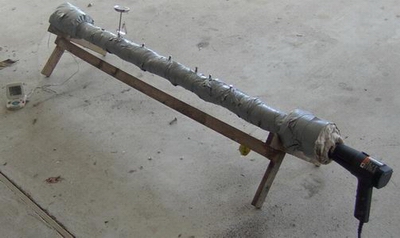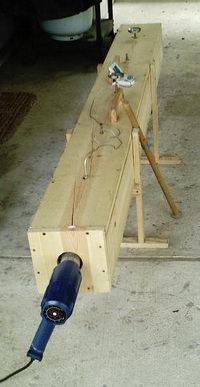Selection, splitting and staggering.
Step two
Straightening
Step threeBasic Beveling

m
 m fly rods
m fly rodsHeat treating
Step five Hand planing 1
Hand planing 2
Step sixHand planing 2
Gluing
Step sevenFinal dimensions
Step eightAttaching hardware
Step nineWrapping
Step tenFinish
Rod sock and tube
Step 12 Shipping and
Customer care
<-last Heat treating next->
home
home
If
you want to see a lively discussion, get a
group of rod builders together and bring up the subject of heat
treating. Everyone has their own idea about what it does to the
bamboo and how best to arrive at that blissful state. Heat
treating drives out moisture and seems to give more "spring" to
the bamboo. Almost
everyone agrees that heat treating is a good thing but there we go our
separate ways.
In general bamboo is "cooked" at between 300°F and the point at which bamboo becomes charcoal. (I've done this.) It's questionable if cooking below 300°F does not do much good. Time is another factor. How long? And then there's the question of ovens. There are several different types: gas, electric and air gun. The requirements for an over are that the oven can hold a constant temperature, between 300° and 400° and be fairly constant in temperature from one end to the other.
 I
fall into the latter camp. I didn't want to try to build a gas or
electric oven, and the cost to buy one was fairly steep.
That left the air gun over. There are two styles of air gun oven
horizontal and vertical. I chose horizontal. My original
oven was a piece of 2" iron pipe wrapped in as much insulation as I
could muster. My original heat gun had two settings, to cold or
to hot. Nor could I expect one end of the tube to be the same
temp as the other end. Switching the heat gun from end to end
helped, but I still had a relatively cool area in the middle of
the oven. Note the electronic thermometer and the manual cooking
thermometer.
I
fall into the latter camp. I didn't want to try to build a gas or
electric oven, and the cost to buy one was fairly steep.
That left the air gun over. There are two styles of air gun oven
horizontal and vertical. I chose horizontal. My original
oven was a piece of 2" iron pipe wrapped in as much insulation as I
could muster. My original heat gun had two settings, to cold or
to hot. Nor could I expect one end of the tube to be the same
temp as the other end. Switching the heat gun from end to end
helped, but I still had a relatively cool area in the middle of
the oven. Note the electronic thermometer and the manual cooking
thermometer.
It quickly became clear that I needed something better so I
re-designed the whole thing, and got a better heat gun. I placed the "oven" in a wooden box filled with insulation. I kept five
ports to test temperature but normally only use three. Over time
I've replaced my mechanical thermometers with electric ones. I
now monitor both ends and the middle of the oven. It takes
about 45 minutes for the over to heat to a fairly standard 325° to
350° The end away from the heat gun is always cooler so I
switch ends at regular intervals.
the "oven" in a wooden box filled with insulation. I kept five
ports to test temperature but normally only use three. Over time
I've replaced my mechanical thermometers with electric ones. I
now monitor both ends and the middle of the oven. It takes
about 45 minutes for the over to heat to a fairly standard 325° to
350° The end away from the heat gun is always cooler so I
switch ends at regular intervals.
First the strips are bound in the following order X, I, XX, II, XXX and III. In other words the strips that will end up on opposite sides of the rod section are placed next to each other. If the strips were placed as they will be in the actual rod, any bends or kinks that exist would be cooked into the sections. This way they counter each other in the finished section.
I preheat to even the temperature through out the oven.
The bound strips are placed on a rack, and inserted in the oven so that each end is an identical distance from the oven openings. The heat gun is adjusted and heat is monitored for a set period of time. Then the heat gun is placed in the other end and the process is repeated. I make this switch several times.
A bound strip on the left
After the overall time I've chosen for the strips to cook, I remove the heat gun and plug the ends of the oven. I let the oven cool on it's own for several hours. By trial and error I can now get a fairly constant heat. I heat for a very long time, usually about 30 to 40 minutes, changing ends every 10 minutes. I do not want color change in my sections. I believe that cooking bamboo to the point of color change can damage the bamboo. But that's just me.
In general bamboo is "cooked" at between 300°F and the point at which bamboo becomes charcoal. (I've done this.) It's questionable if cooking below 300°F does not do much good. Time is another factor. How long? And then there's the question of ovens. There are several different types: gas, electric and air gun. The requirements for an over are that the oven can hold a constant temperature, between 300° and 400° and be fairly constant in temperature from one end to the other.
they never agree.

First the strips are bound in the following order X, I, XX, II, XXX and III. In other words the strips that will end up on opposite sides of the rod section are placed next to each other. If the strips were placed as they will be in the actual rod, any bends or kinks that exist would be cooked into the sections. This way they counter each other in the finished section.
I preheat to even the temperature through out the oven.
The bound strips are placed on a rack, and inserted in the oven so that each end is an identical distance from the oven openings. The heat gun is adjusted and heat is monitored for a set period of time. Then the heat gun is placed in the other end and the process is repeated. I make this switch several times.
A bound strip on the left
After the overall time I've chosen for the strips to cook, I remove the heat gun and plug the ends of the oven. I let the oven cool on it's own for several hours. By trial and error I can now get a fairly constant heat. I heat for a very long time, usually about 30 to 40 minutes, changing ends every 10 minutes. I do not want color change in my sections. I believe that cooking bamboo to the point of color change can damage the bamboo. But that's just me.